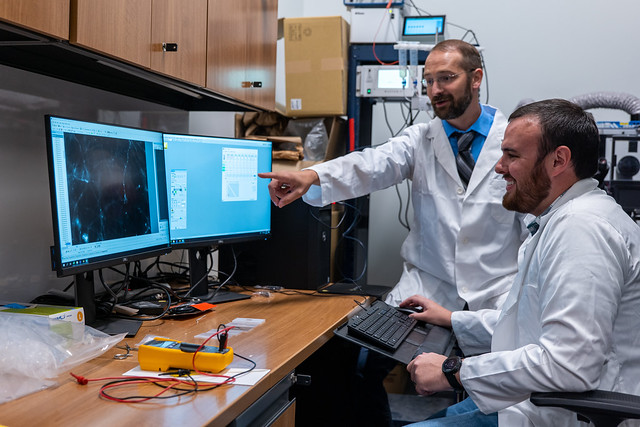Auburn physics professor working to understand networks in brains
Article body
Inside the Leach Science Center at Auburn University, one will find Michael Gramlich’s lab with a cutting-edge microscope that can image neurons that mimic the inside of the human brain.
The microscope and lab have capabilities that very few labs in the world possess.
“Our microscope reproduces the environment of the brain functions and gives us a chance to observe functions as they would normally occur in the human body,” said Gramlich, an assistant professor in the College of Sciences and Mathematics’ Department of Physics.
Biophysics is an exciting cross-disciplinary field that brings together biology, physics, philosophy and neuroscience; it gives researchers incredible insight into the brain and the ability to work on answering fundamental questions about how our minds work.
“Think of connections between neurons in the brain as a large chain of grocery stores connected by a distribution network,” Gramlich said. “The aisles are fully stocked with items, similar to how synaptic connections in the brain contain a collection of proteins and molecules. Since the store does not make most of the goods, it relies on its supply chain to replenish them. Whenever one store needs more of an item, it relies on a distribution network to obtain that item from another store nearby or from the manufacture center.”
But when the grocery store distribution network breaks down, the individual stores can no longer keep items they need in stock.
“Think about a highway that is riddled with potholes. The difficult commute would reduce efficiency and would not be the best way to transport items,” Gramlich shared.
So how does the brain transport these proteins and molecules?
“Neurons utilize the same distribution processes when they determine a particular protein at one connection is needed at a neighboring connection on the same neuron,” he explained. “This internal network includes both short local roads and long-distance highways, similar to the grocery store distribution network.”
The neurophysics lab seeks to determine if the same breakdown processes happen within the neuron whenever the distribution network stops working. “We are looking at the highway in the brain to understand how it functions, so we can improve the process and treat issues,” he added.
The cutting-edge technology in his lab gives him an opportunity to research these behaviors.
“To study the breakdown processes, we grow and study hippocampal cells because they are used in memory and cognition. Breakdown in the connections in the hippocampus cells would significantly inhibit our ability to think and remember efficiently. We grow these cells and tag proteins that are shared between connections at the molecular level. We can manipulate the cells to see how they respond with and without a specific protein,” Gramlich said. “We can then test and simulate behavior in a real brain that will help us create truly transformative research.”
Related Media
Media interested in this story can contact Communications Director Preston Sparks at (334) 844-9999 or preston.sparks@auburn.edu.
Auburn University is a nationally ranked land grant institution recognized for its commitment to world-class scholarship, interdisciplinary research with an elite, top-tier Carnegie R1 classification, life-changing outreach with Carnegie’s Community Engagement designation and an undergraduate education experience second to none. Auburn is home to more than 30,000 students, and its faculty and research partners collaborate to develop and deliver meaningful scholarship, science and technology-based advancements that meet pressing regional, national and global needs. Auburn’s commitment to active student engagement, professional success and public/private partnership drives a growing reputation for outreach and extension that delivers broad economic, health and societal impact.







